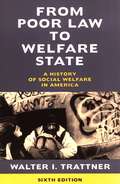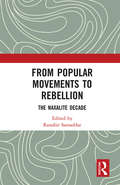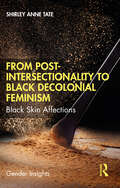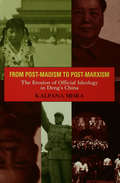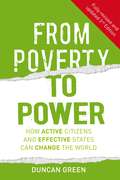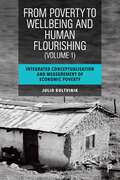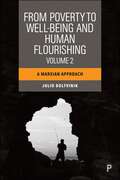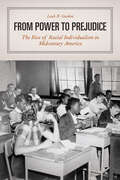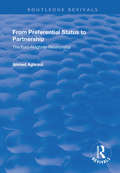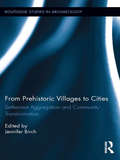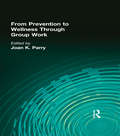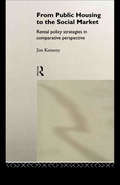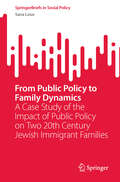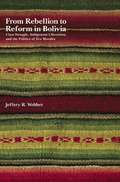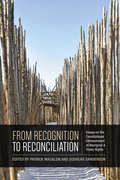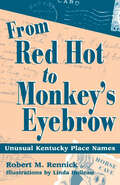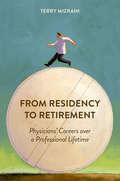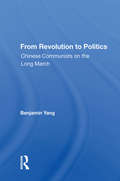- Table View
- List View
From Pompeii
by Ingrid D. RowlandWhen Vesuvius erupted in 79 CE, the force of the explosion blew the top right off the mountain, burying nearby Pompeii in a shower of volcanic ash. Ironically, the calamity that proved so lethal for Pompeii's inhabitants preserved the city for centuries, leaving behind a snapshot of Roman daily life that has captured the imagination of generations. The experience of Pompeii always reflects a particular time and sensibility, says Ingrid Rowland. From Pompeii: The Afterlife of a Roman Town explores the fascinating variety of these different experiences, as described by the artists, writers, actors, and others who have toured the excavated site. The city's houses, temples, gardens--and traces of Vesuvius's human victims--have elicited responses ranging from awe to embarrassment, with shifting cultural tastes playing an important role. The erotic frescoes that appalled eighteenth-century viewers inspired Renoir to change the way he painted. For Freud, visiting Pompeii was as therapeutic as a session of psychoanalysis. Crown Prince Hirohito, arriving in the Bay of Naples by battleship, found Pompeii interesting, but Vesuvius, to his eyes, was just an ugly version of Mount Fuji. Rowland treats readers to the distinctive, often quirky responses of visitors ranging from Wolfgang Amadeus Mozart, Charles Dickens, and Mark Twain to Roberto Rossellini and Ingrid Bergman. Interwoven throughout a narrative lush with detail and insight is the thread of Rowland's own impressions of Pompeii, where she has returned many times since first visiting in 1962.
From Poor Law to Welfare State, 6th Edition: A History of Social Welfare in America
by Walter I. TrattnerOver twenty-five years and through five editions, Walter I. Trattner's From Poor Law to Welfare State has served as the standard text on the history of welfare policy in the United States. The only comprehensive account of American social welfare history from the colonial era to the present, the new sixth edition has been updated to include the latest developments in our society as well as trends in social welfare.<P><P> Trattner provides in-depth examination of developments in child welfare, public health, and the evolution of social work as a profession, showing how all these changes affected the treatment of the poor and needy in America. He explores the impact of public policies on social workers and other helping professions -- all against the backdrop of social and intellectual trends in American history. From Poor Law to Welfare State directly addresses racism and sexism and pays special attention to the worsening problems of child abuse, neglect, and homelessness. Topics new to this sixth edition include:<P> * A review of President Clinton's health-care reform and its failure, and his efforts to "end welfare as we know it"<P> * Recent developments in child welfare including an expanded section on the voluntary use of children's institutions by parents in the nineteenth century, and the continued discrimination against black youth in the juvenile justice system<P> * An in-depth discussion of Charles Murray and Richard Herrnstein's controversial book, The Bell Curve, which provided social conservatives new weapons in their war on the black poor and social welfare in general<P> * The latest information on AIDS and the reappearance of tuberculosis -- and their impact on public health policy<P> * A new Preface and Conclusion, and substantially updated Bibliographies<P> Written for students in social work and other human service professions, From Poor Law to Welfare State: A History of Social Welfare in America is also an essential resource for historians, political scientists, sociologists, and policymakers.
From Popular Culture to Everyday Life
by John StoreyFrom Popular Culture to Everyday Life presents a critical exploration of the development of everyday life as an object of study in cultural analysis, wherein John Storey addresses the way in which everyday life is beginning to replace popular culture as a primary concept in cultural studies. Storey presents a range of different ways of thinking theoretically about the everyday; from Freudian and Marxist approaches, to chapters exploring topics such as consumption, mediatization and phenomenological sociology. The book concludes, drawing from the previous nine chapters, with notes towards a definition of what everyday life might look like as a pedagogic object of study in cultural studies. This is an ideal introduction to the theories of everyday life for both undergraduate and postgraduate students of cultural studies, communication studies and media studies.
From Popular Movements to Rebellion: The Naxalite Decade
by Ranabir SamaddarFrom Popular Movements to Rebellion: The Naxalite Decade argues that without an understanding of the popular sources of the rebellion of that time, the age of the Naxalite revolt will remain beyond our understanding. Many of the chapters of the book bring out for the first time unknown peasant heroes and heroines of that era, analyses the nature of the urban revolt, and shows how the urban revolt of that time anticipated street protests and occupy movements that were to shake the world forty-fifty years later. This is a moving and poignant book. Some of the essays are deeply reflective about why the movement failed and was at the end alienated. Ranabir Samaddar says that, the Naxalite Movement has been denied a history. The book also carries six powerful short stories written during the Naxalite Decade and which are palpably true to life of the times. The book has some rare photographs and ends with newspaper clippings from the period. As a study of rebellious politics in post-Independent India, this volume with its focus on West Bengal and Bihar will stand out as an exceptional history of contemporary times. From Popular Movements to Rebellion: The Naxalite Decade will be of enormous relevance to students and scholars of history, politics, sociology and culture, and journalists and political and social activists at large. Please note: Taylor & Francis does not sell or distribute the Hardback in India, Pakistan, Nepal, Bhutan, Bangladesh and Sri Lanka
From Post-Intersectionality to Black Decolonial Feminism: Black Skin Affections (Gender Insights)
by Shirley Anne TateIn this accessible and yet challenging work, Shirley Anne Tate engages with race and gender intersectionality, connecting through to affect theory, to develop a Black decolonial feminist analysis of global anti-Blackness. Through the focus on skin, Tate provides a groundwork of historical context and theoretical framing to engage more contemporary examples of racist constructions of Blackness and Black bodies. Examining the history of intersectionality including its present ‘post-intersectionality’, the book continues intersectionality’s racialized gender critique by developing a Black decolonial feminist approach to cultural readings of Black skin’s consumption, racism within ‘body beauty institutions’ (e.g. modelling, advertising, beauty pageants) and cultural representations, as well as the affects which keep anti-Blackness in play. This book is suitable for undergraduate and postgraduate students in gender studies, sociology and media studies.
From Post-Maoism to Post-Marxism: The Erosion of Official Ideology in Deng's China
by Kalpana MisraThis text chronicles Deng Xiaoping's institution of far-reaching and practical economic reforms that seem at odds with Communist theory and its emphasis on ideology. In fact, while Deng often turned to Mao for ideological justification of his reforms, those very reforms seemed to wear away to official ideology. Ultimately, even though the post-Mao
From Poverty to Power: How Active Citizens and Effective States Can Change the World (Second Edition)
by Duncan GreenThe book discusses different types of initiatives across the world that have enhanced and expanded the powers of the powerless and emphasizes how 'active citizenship' can be a very effective way of seeking solutions.
From Poverty to Well-Being and Human Flourishing (Volume 1): Integrated Conceptualisation and Measurement of Economic Poverty
by Julio BoltvinikThis book offers a holistic view of Julio Boltvinik’s vast and important work on poverty conceptualisation and measurement. While well known to Spanish-speaking audiences, this volume brings these works together to offer access for English-speaking audiences for the first time. The book provides the foundations, application and empirical examples of Boltvinik’s Integrated Poverty Measurement Method, which could potentially transform poverty narratives globally as it has done in Mexico. Deeply critical of available poverty approaches, it provides a challenging and radically new way of conceiving and measuring poverty, offering the only multidimensional poverty measurement method which includes time poverty and allows all Aggregate Poverty Measures to be fully calculated.
From Poverty to Well-Being and Human Flourishing (Volume 2): A Marxian Approach
by Julio BoltvinikFollowing the highly respected first volume, this book continues to provide a holistic view of Julio Boltvinik’s vast and important work on poverty conceptualisation and measurement. While the previous book introduced the author’s widely adopted Integrated Poverty Measurement Method (IPMM), this new volume outlines his Marxian approach to poverty and human flourishing, focusing on what he conceptualises as human poverty. Bringing together 20 years of research, this interdisciplinary book provides an alternative to Sen’s Capability approach and details its internal consistency, solid foundations and promising perspectives for applicability.
From Power to Prejudice: The Rise of Racial Individualism in Midcentury America
by Leah N. GordonAmericans believe strongly in the socially transformative power of education, and the idea that we can challenge racial injustice by reducing white prejudice has long been a core component of this faith. How did we get here? In this first-rate intellectual history, Leah N. Gordon jumps into this and other big questions about race, power, and social justice. To answer these questions, From Power to Prejudice examines American academia--both black and white--in the 1940s and ’50s. Gordon presents four competing visions of "the race problem” and documents how an individualistic paradigm, which presented white attitudes as the source of racial injustice, gained traction. A number of factors, Gordon shows, explain racial individualism’s postwar influence: individuals were easier to measure than social forces; psychology was well funded; studying political economy was difficult amid McCarthyism; and individualism was useful in legal attacks on segregation. Highlighting vigorous midcentury debate over the meanings of racial justice and equality, From Power to Prejudice reveals how one particular vision of social justice won out among many contenders.
From Power to Prejudice: The Rise of Racial Individualism in Midcentury America
by Leah N. GordonAmericans believe strongly in the socially transformative power of education, and the idea that we can challenge racial injustice by reducing white prejudice has long been a core component of this faith. How did we get here? In this first-rate intellectual history, Leah N. Gordon jumps into this and other big questions about race, power, and social justice. To answer these questions, From Power to Prejudice examines American academia—both black and white—in the 1940s and ’50s. Gordon presents four competing visions of “the race problem” and documents how an individualistic paradigm, which presented white attitudes as the source of racial injustice, gained traction. A number of factors, Gordon shows, explain racial individualism’s postwar influence: individuals were easier to measure than social forces; psychology was well funded; studying political economy was difficult amid McCarthyism; and individualism was useful in legal attacks on segregation. Highlighting vigorous midcentury debate over the meanings of racial justice and equality, From Power to Prejudice reveals how one particular vision of social justice won out among many contenders.
From Preferential Status to Partnership: The Euro-Maghreb Relationship
by Ahmed AghroutThis title was first published in 2000. Moving from general principles and determinants to the growing co-operation between the European Community and Maghreb states, and then onto the EU's responses to recent problems in Maghreb countries, this study concludes that a more assertive EU presence is needed, otherwise there will be damaging costs for the already fragile regional stability. The text mixes historical, political and economic analysis.
From Prehistoric Villages to Cities: Settlement Aggregation and Community Transformation (Routledge Studies in Archaeology #10)
by Jennifer BirchArchaeologists have focused a great deal of attention on explaining the evolution of village societies and the transition to a ‘Neolithic’ way of life. Considerable interest has also concentrated on urbanism and the rise of the earliest cities. Between these two landmarks in human cultural development lies a critical stage in social and political evolution. Throughout world, at various points in time, people living in small, dispersed village communities have come together into larger and more complex social formations. These community aggregates were, essentially, middle-range; situated between the earliest villages and emergent chiefdoms and states. This volume explores the social processes involved in the creation and maintenance of aggregated communities and how they brought about revolutionary transformations that affected virtually every aspect of a society and its culture. While there have been a number of studies that address coalescence from a regional perspective, less is understood about how aggregated communities functioned internally. The key premise explored in this volume is that large-scale, long-term cultural transformations were ultimately enacted in the context of daily practices, interactions, and what might be otherwise considered the mundane aspects of everyday life. How did these processes play out "on the ground" in diverse and historically contingent settings? What are the strategies and mechanisms that people adopt in order to facilitate living in larger social formations? What changes in social relations occur when people come together? This volume employs a broadly cross-cultural approach to interrogating these questions, employing case studies which span four continents and more than 10,000 years of human history.
From Prevention to Wellness Through Group Work
by Joan K ParryOffering some of the most advanced thinking and practice in the arena of social work with groups, From Prevention to Wellness Through Group Work synthesizes the discussions and findings from the Annual Symposium of the Association for the Advancement of Social Work with Groups (AASWG). Gathered here are different ideas, techniques, and research (with a focus on prevention) for group work with seniors, adults, teens, and children. With a mix of authors from social work academia and practice, this book gives you groundbreaking theoretical pieces as well as emerging skills and techniques in group work. If you attended the conference you will refer to this book as a guide to the information presented. If you were not in attendance you need this book to discover what you missed!The two primary chapters in From Prevention to Wellness Through Group Work provide a look into constructivism and the power model and the empowerment approach as a paradigm for international social work practice. Other pertinent topics you learn about include: conflict management in group treatment a social skills program for emotionally disturbed children bullying and scapegoating in groups groups for persons who have experienced transplants groups for persons with AIDS the intersection of different realities in the group setting using poetry to revive traditional practice methods, theories, and values mutual aid, democratic participation, power sharing, and consciousness raisingFrom Prevention to Wellness Through Group Work also shows you how group experiences prevent breakdown and encourage wellness for older adults in senior centers and retirement communities; the definition, scope, and usefulness of psychoeducational groups; how group-based methods can enrich research; and how monitoring group practice can strengthen your effectiveness and credibility. You’ll find the book’s consistent focus on prevention while providing ways to improve both group work practice and research through cooperative efforts most helpful.
From Protest to President: A Social Justice Journey through the Emergence of Adult Education and the Birth of Distance Learning
by George A PruittFrom Protest to President describes an inspirational odyssey of a young, Black activist coming of age in Mississippi and Chicago in the tumultuous 1960s and '70s, culminating in a notable thirty-five-year presidency at Thomas Edison State University. From barbershop encounters with Malcolm X to death threats at Illinois State University and gunfire at Towson State, Pruitt provides a powerful narrative poised at the intersection of social justice, higher education and politics. He recounts leadership experiences at HBCUs and public universities across the country, as he advocated for autonomy at Morgan State and fought to preserve Tennessee State University. His steadfast activism, integrity and courage led to groundbreaking work in providing access to higher education for working adults and the military. From his days as a student protester in high school and college to his appearances on Capitol Hill, Pruitt has earned the reputation as a candid and influential leader in higher education.
From Public Housing Soc Market
by J KemenyJim Kemeny develops a conceptual framework to present a critical study of comparative rental markets. The framework centres around the concept of the process of maturation of cost rental housing and two policies for handling this which have been adopted by industrial societies. These are, firstly, the Anglo-Saxon "dualist" system, seen in Great Britain, Australia and New Zealand, and secondly, the Germanic "unitary market" system, seen in Sweden, The Netherlands, Germany and Switzerland. Using a comparative approach based around international case studies, Jim Kemeny shows how each system stems from different power structures, is governed by different policy strategies, and is informed by different ideological views of how markets operate. Offering a radical critique of the orthodox view, it is argued that the time is now right for English-speaking nations to abandon state control over cost renting but allow to it to compete directly with profit renting, as in the "unitary market" model. International in scope, this volume should be of interest to researchers in housing, sociology and related fields.
From Public Policy to Family Dynamics: A Case Study of the Impact of Public Policy on Two 20th Century Jewish Immigrant Families (SpringerBriefs in Social Policy)
by Sana LoueThis compact book relies on the story of two intertwined Jewish immigrant families to tell a multigenerational Jewish story about the interplay between public/social policy, cultural categories, and the lived experience of working class immigrant Jews from Eastern Europe, including trans-/intergenerational trauma. Importantly, it focuses on the impacts of pre-Holocaust public policy, a significant departure from the Holocaust and post-Holocaust focus of much of the published literature relating to Jewish intergenerational trauma. As such, it offers the possibility of better understanding the far-reaching and perhaps unforeseen impacts of public policy. This book addresses events on both the micro and macro levels and is biographical, autobiographical, and historical in its scope. Sources for this work include archival materials, census records, maps, military records, birth and death certificates, congressional materials, newspaper articles, films, images, interviews with living family members, and secondary sources. Among the topics covered are: Russian, Soviet, and U.S. Eugenics: Family Internalization of Policy and Rhetoric The Intertwined Impact of Economics, Eugenic Policy, and Immigration Restrictions The Present Past: Policy, Identity, and Progeny From Public Policy to Family Dynamics: A Case Study of the Impact of Public Policy on Two 20th Century Jewish Immigrant Families adds a human face to writings related to public/social policy. As the book integrates understandings from diverse fields of study, students of public policy, social work, psychology, history, Jewish studies, immigration studies, bioethics, and public health, as well as social workers, bioethicists, and historians, would be most interested in reading this unique work.
From Rabbit Ears to the Rabbit Hole: A Life with Television
by Kathleen CollinsFor the past several years, critics have been describing the present era as both “the end of television” and one of “peak TV,” referring to the unprecedented quality and volume and the waning of old technologies, formats, and habits. Television’s projections and reflections have significantly contributed to who we are individually and culturally. From Rabbit Ears to the Rabbit Hole: A Life with Television reveals the reflections of a TV scholar and fan analyzing how her life as a consumer of television has intersected with the cultural and technological evolution of the medium itself. In a narrative bridging television studies, memoir, and comic, literary nonfiction, Kathleen Collins takes readers alongside her from the 1960s through to the present, reminiscing and commiserating about some of what has transpired over the last five decades in the US, in media culture, and in what constitutes a shared cultural history. In a personal, critical, and entertaining meditation on her relationship with TV—as avid consumer and critic—she considers the concept and institution of TV as well as reminiscing about beloved, derided, or completely forgotten content. She describes the shifting role of TV in her life, in a progression that is far from unique, but rather representative of a largely collective experience. It affords a parallel coming of age, that of the author and her coprotagonist, television. By turns playful and serious, wry and poignant, it is a testament to the profound and positive effect TV can have on a life and, by extrapolation, on the culture.
From Rabin to Netanyahu: Israel's Troubled Agenda (Israeli History, Politics and Society)
by Efraim KarshBenjamin Netanyahu's 1996 election victory marked a major turnaround in his fortunes, for only a few months earlier his political career had seemed finished. This book examines what his victory means both domestically and internationally.
From Rebellion to Reform in Bolivia
by Jeffery R. WebberEvo Morales rode to power on a wave of popular mobilizations against the neoliberal policies enforced by his predecessors. Yet many of his economic policies bare striking resemblance to the status quo he was meant to displace. Based in part on dozens of interviews with leading Bolivian activists, Jeff Webber examines the contradictions of Morales' first term in office.
From Recognition to Reconciliation: Essays on the Constitutional Entrenchment of Aboriginal and Treaty Rights
by Douglas Sanderson Patrick MacklemMore than thirty years ago, section 35 of the Constitution Act recognized and affirmed "the existing aboriginal and treaty rights of the aboriginal peoples of Canada." Hailed at the time as a watershed moment in the legal and political relationship between Indigenous peoples and settler societies in Canada, the constitutional entrenchment of Aboriginal and treaty rights has proven to be only the beginning of the long and complicated process of giving meaning to that constitutional recognition.In From Recognition to Reconciliation, twenty leading scholars reflect on the continuing transformation of the constitutional relationship between Indigenous peoples and the Canadian state. The book features essays on themes such as the role of sovereignty in constitutional jurisprudence, the diversity of methodologies at play in these legal and political questions, and connections between the Canadian constitutional experience and developments elsewhere in the world.
From Red Hot to Monkey's Eyebrow: Unusual Kentucky Place Names
by Robert M. RennickYou can find Paradise in Kentucky—along with many other quirky place names, and the truth (and tall tales) behind them . . .Encountering some of the uncommon geographical names in the Commonwealth of Kentucky for the first time, visitors and residents alike often assume that some clever or funny stories lie behind them. So they ask, how did Elkhorn Creek get its name? Were the roads to Red River really Hell each way? Did bugs really tussle in Monroe County? Why was everyone whooping for Larry?To be hospitable and helpful, Kentuckians have come up with convincing?if not always truthful?answers to these and other questions about how places got their names. Some of these stories were clearly not intended to be believed, though a few of them have been anyway. From Red Hot to Monkey’s Eyebrow presents some of the classic accounts of Kentucky’s oddest place names. Complete with map, index, and humorous drawings by Linda Boileau, this handy guide is a geography lover’s delight.
From Residency to Retirement: Physicians' Careers over a Professional Lifetime (Critical Issues in Health and Medicine)
by Terry MizrahiFrom Residency to Retirement tells the stories of twenty American doctors over the last half century, which saw a period of continuous, turbulent, and transformative changes to the U.S. health care system. The cohort’s experiences are reflective of the generation of physicians who came of age as presidents Carter and Reagan began to focus on costs and benefits of health services. Mizrahi observed and interviewed these physicians in six timeframes ending in 2016. Beginning with medical school in the mid-1970s, these physicians reveal the myriad fluctuations and uncertainties in their professional practice, working conditions, collegial relationships, and patient interactions. In their own words, they provide a “view from the front lines” both in academic and community settings. They disclose the satisfactions and strains in coping with macro policies enacted by government and insurance companies over their career trajectory. They describe their residency in internal medicine in a large southern urban medical center as a “siege mentality” which lessened as they began their careers, in Getting Rid of Patients, the title of Mizrahi’s first book (1986). As these doctors moved on in their professional lives more of their experiences were discussed in terms of dissatisfaction with financial remuneration, emotional gratification, and intellectual fulfillment. Such moments of career frustration, however, were also interspersed with moments of satisfaction at different stages of their medical careers. Particularly revealing was whether they were optimistic about the future at each stage of their career and whether they would recommend a medical career to their children. Mizrahi's subjects also divulge their private feelings of disillusionment and fear of failure given the malpractice epidemic and lawsuits threatened or actually brought against so many doctors. Mizrahi’s work, covering almost fifty years, provides rarely viewed insights into the lives of physicians over a professional life span.
From Reverence to Rape: The Treatment of Women in the Movies
by Molly HaskellThe “groundbreaking study” of female representation in film, now with a new introduction by the author (New York Times Book Review).A landmark of feminist cinema criticism, Molly Haskell’s From Reverence to Rape remains as insightful, searing, and relevant as it was when it first appeared in 1974. Ranging across time and genres from the golden age of Hollywood to films of the late twentieth century, Haskell analyzes images of women in movies, the relationship between these images and the status of women in society, the stars who fit these images or defied them, and the attitudes of their directors. This new edition features both a new foreword by New York Times film critic Manohla Dargis and a new introduction from the author that discusses the book’s reception and the evolution of her views.
From Revolution To Politics: Chinese Communists On The Long March
by Benjamin YangProviding fresh analysis of the history and politics of Chinese communism, this book utilizes previously inaccessible sources to reassess the epic Long March. It sheds new light on the revolutionary momentum and political structure of the Chinese Communist Party in the 1930s.

